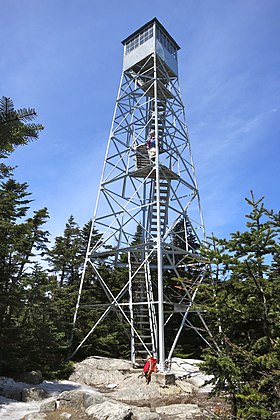Stratton Mountain, Vermont
| Stratton Mountain | |
|---|---|

Summit of Stratton Mountain
|
|
| Highest point | |
| Elevation | 3,940 ft (1,200 m) |
| Prominence | 2,410 ft (730 m) |
| Listing | #21 New England Fifty Finest #73 New England 100 Highest |
| Coordinates | 43°5.17′N 72°55.51′W / 43.08617°N 72.92517°WCoordinates: 43°5.17′N 72°55.51′W / 43.08617°N 72.92517°W |
| Geography | |
| Location | Windham County, Vermont |
| Parent range | Green Mountains |
| Topo map | USGS Stratton Mountain |
| Climbing | |
| Easiest route | Ski lift |
Stratton Mountain is a mountain located in Windham County, Vermont, in the Green Mountain National Forest. The mountain is the highest point of Windham County, and of the southern Green Mountains generally. A fire tower located on the summit is generally open for climbing by the public. There is also a small caretaker cabin (not open to the public) at the summit that is inhabited in season by a caretaker from the Green Mountain Club.
Stratton Mountain stands within the watershed of the Connecticut River, which drains into Long Island Sound in Connecticut. The south and southeast slopes of Stratton Mountain drain into Ball Mountain Brook, thence into the West River, and into the Connecticut River. The east side of Stratton drains via Kidder Brook into the North Branch of Ball Mountain Brook. The north side of Stratton drains into the North Branch of Ball Mountain Brook. The northwest side of Stratton drains into the Winhall River, and thence into the West River. The southwest slopes of Stratton drain into the East Branch of the Deerfield River, another tributary of the Connecticut.
The mountain has two peaks, of which the southern one is the highest, at 3940 feet. The mountain ridge descends to northward to a saddle at 3830 feet, before rising to the north peak at 3875 feet. The south summit is wooded, except for the small clearing housing the tower and caretaker's cabin. The tower was built about 1934 by a crew of the Civilian Conservation Corps, and the cabin dates to about 1970. The tower is the subject of a 1992 listing on the National Register of Historic Places, as one of the state's last surviving towers, and one of the last three to be taken out service for fire spotting (in 1982).
...
Wikipedia
